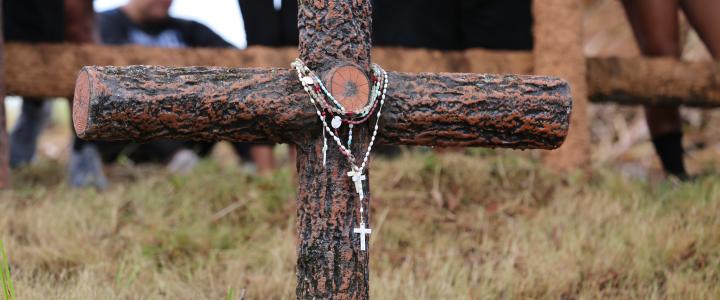
July 21 is a significant day for Guam as people from every inch of the island commemorate Guam’s Liberation Day. Seventy-five years ago, on July 21, 1944, the 3rd Marine Division stormed the island’s beaches off the coasts of Asan and Agat to recapture the island from the Japanese Imperial Army.
Marines fought their way toward the center of the island to Manenggon in Yona, the site of Guam’s largest concentration camp. It was there that CHamoru men, women and children found re-invigorated hope in America’s return to the island.
Though many CHamoru lives were lost during the war, the people of Guam remember and pay them homage every year at these memorial sites. Each memorial serves as a reminder of those who came before us, those who suffered the pains of war and to remind us to never forget the struggles our people endured.
If you’re visiting the island, be sure to visit these sites listed below:
Manenggon
The Manenggon Memorial is the site of Guam’s largest concentration camp during World War II. At that time, it was home to 75% of the island’s population. U.S. Marines worked their way inland from the beaches to free the CHamoru people interred at the camp. Today, an annual memorial ceremony is held to honor the victims and survivors of the war.
Marine 5th Field Service Depot Monument
As one of the newer memorial sites, the Marine 5th Field Service Depot Monument in the village of Maite pays tribute to the U.S. Marine supply outlet that was established after the island’s liberation. Following the war, Guam residents found jobs at the depot and moved to the village to be closer to the Marines.
Kålaguac Memorial Monument
The Kålaguac Memorial Monument in Barrigada is in memory of the families who were forced from their homes by Japanese soldiers to construct an airfield at Tiyan.
Asinan
The first memorial for the Asinan concentration camp was held earlier this month with a ceremony in honor of those who were forced to this smaller camp in Yona.
Mangilao Memorial
Located at the Mangilao Mayor’s Office, the Mangilao Memorial Monument honors the victims and survivors from World War II who suffered at the hands of the Japanese.
Asan Landing
As the sun rose over the island on July 21, 1944, U.S. Marines fought to reclaim the island from the Japanese on the shores of Asan. The annual Asan Landing Memorial honors the brave Marines who fought for the Liberation of Guam and her people.
Tinta/Faha
Nearing the end of the Japanese occupation of Guam, imperial forces gathered about 800 residents of the village of Merizo and herded them into the Tinta and Faha caves. Coercing the residents into thinking they were being brought there to work, the Japanese threw hand grenades into the caves, killing many of the CHamorus. The annual Tinta/Faha memorial and mass is held to remember these victims.
Fena
Located in the village of Santa Rita is Fena Cave. After Marines invaded the island, Japanese forces killed more than 30 CHamorus, specifically Santa Rita and Agat residents, here with grenades and bayonets.
Now being naval property, the cave is not accessible to the public year-round. A monument at the Old Agat Cemetery is dedicated to those who suffered and died.
Sumay
The historic village of Sumay was the economic hub of the island before the war. On Dec. 8, 1941, the Japanese dropped bombs in the village, disabling communication systems and killing village residents. Following the war, the U.S. Navy occupied Sumay and moved residents to the nearby village of Santa Rita.
Every year, former Sumay residents and their descendants take part in an annual mass on the Naval Base to pray for loved ones lost during the war.
Chagui'an
As the United States continued to secure the island, 45 CHamoru men were taken from Manenggon and forced by Japanese soldiers to carry supplies to Yigo. These soldiers then killed the men to prevent them from sharing information. Though the massacre was only discovered in recent years, a memorial is held to remember the CHamoru men who lost their lives.













